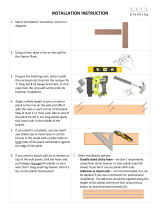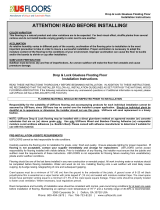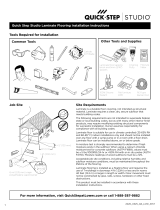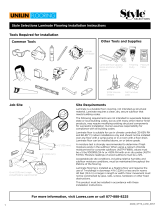Design Innovations 51004 Installation guide
- Type
- Installation guide

Project Planning
Calculate planking cartons needed. Multiply the footage of the height and width of the areas
to be covered and then divide the total by the square footage per your application selection
(9.5 sq ft for Flush installation, 10.5 sq ft for Channel Groove installation and 8.5 sq ft for
Overlap installation) to determine the amount of planking cartons required.
Installation Instructions
BE PREPARED - Suggested tools you may need: fine tooth saw and miter box, hammer, ruler,
plane, level, carpenter’s combination square, 1" finishing nails or power brad nail gun, nail
set and panel adhesive.
ACCLIMATION REQUIREMENTS - In order to minimize the expansion and contraction of your
planks you must take the following steps prior to installation: Open all packages and place
the planks flat with spacers in between the planks to allow air to circulate around each
plank. Allow 36 hours for the planks to adjust to the humidity and temperature of the room
in which they are being installed. Do not attempt to acclimate your planks in a damp
unheated area which would not be representative of the true year round temperature of the
room. Important: In rooms that are below grade, apply a vapor barrier between the studs
and the planking. In rooms that have unusually high moisture conditions such as saunas,
bathrooms or laundry rooms, acclimation and finish sealing must be applied. Expansion and
contraction are inherent characteristics of all wood products due to changes in humidity
within the room. The manufacturer cannot be held liable for any movement in the planks.
SELECTING PLANKS – First determine if you want to install the planking showing the
Weathered/Aged side or the Rough Sawn side. Then select the planks you want to mix on
the wall. It is recommended to install mixing the colors so you don’t end up installing all
lighter colors and then all darker colors together. Better to mix the light and dark together
as much as possible so your finished wall looks evenly random colors.
WALL PREPARATION - If your walls are in good condition you may glue and nail the planking
directly onto drywall, plywood or existing paneling. On uneven, cracked or very rough walls,
repair and smooth out the wall so planking will lay flat against a sturdy wall.
GENERAL – GPS Ship-Lap Planking is solid wood which may cup or have a bend in the length,
it is recommended to use nails when necessary to hold down areas that will not naturally lay
flush when installed. Angle all nails for greater holding power. Hammer nails to within 1/8"
of face, then finish with a nail set. Glue each plank to the wall with a quality panel adhesive
and follow the manufacturer’s instructions. From time to time, check for plumb/level and if
necessary, slightly angle the plank to make it level. Do not butt up planks too tightly to
allow for normal expansion and contraction.
CHECK FOR PLUMB - The first plank is the key to a successful and easy installation. Using a
level, make sure the first plank is absolutely straight. Where necessary, scribe and then
plane or cut the long edge to assure a level fit.
METHODS OF INSTALLATION – The ship-lap planks can be installed three different ways:
1-Ship-Lap Flush: Installing the planks flush against the wall and closing the joint to show
just an eased edge between each plank.

2- Ship-Lap Channel Groove: Installing the planks flush top the wall and putting a small
spacer in between the planks to show a small channel in between the plank lengths.
3- Ship-Lap Overlay: Installing the planks against the wall at the tops edge but overlapping
the front surface of the plank below it. This results in the ship-lap siding installation.
HORIZONTAL APPLICATION - Install the first plank with the lap groove edge down and 1/4"
off the floor. Make sure the bottom row of planking is level. As you install up the wall be
sure to keep the plank ship lapped ends staggered. When installing the top plank, leave
1/4" between the ceiling and the planks.
VERTICAL APPLICATION - Leave 1/4" space at the corner, top and bottom and begin at an
inside corner and work left to right if you are right handed work right to left if you are left
handed. Keep the lap edge toward the starting corner and the flat edges toward your work
direction. Face nails and glue the first plank. Angle nail the planks every 16" will insure
adhesive contact to the planks and wall. Measure and fit the next planks carefully checking
for plumb as you work across the wall. The last plank may have to be trimmed to fit into a
corner.
DIAGONAL APPLICATION - Start the planking at an inside floor corner location. Cut and fit a
triangular shaped piece at a 45° angle to the corner keeping the lap edge toward the
starting corner and the flat edge toward the work direction. Nail and glue the triangular
piece into the corner. Proceed by marking, cutting and installing the remainder of the
planks using the same as the above procedures.
CEILING APPLICATION - Install the same as vertical application. Be sure, the planking must
be nailed and glued to a solid surface.
FINISHING - is not required if installing in a moderate climate condition. If you desire to seal
the surfaces or add a satin or glossy finish then you can use a polyurethane type finish. For
best results brush on the finish.
-
 1
1
-
 2
2
Design Innovations 51004 Installation guide
- Type
- Installation guide
Ask a question and I''ll find the answer in the document
Finding information in a document is now easier with AI
Related papers
Other documents
-
 Easy Planking 11232 Installation guide
Easy Planking 11232 Installation guide
-
 Vintage Timber 2102 Operating instructions
Vintage Timber 2102 Operating instructions
-
 Easy Planking E-107 Installation guide
Easy Planking E-107 Installation guide
-
 natural floors 77L61500 Installation guide
natural floors 77L61500 Installation guide
-
 natural floors 6010WS Installation guide
natural floors 6010WS Installation guide
-
 QuickStep QS907 Installation guide
QuickStep QS907 Installation guide
-
 QuickStep QS902 Installation guide
QuickStep QS902 Installation guide
-
 Style Selections LWCAR306 Installation guide
Style Selections LWCAR306 Installation guide
-
Pergo LF000900 Installation guide
-
Mohawk LSO23-62 Installation guide











